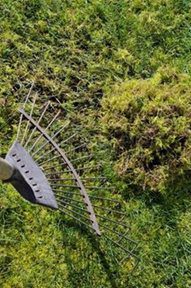Scarifying should be an important part of a lawn maintenance routine. It can leave the lawn looking patchy and unattractive; don’t worry though, this appearance is temporary and for the greater good.
By removing the build-up of dead grass, moss and weeds you are providing the healthy grass a better opportunity to strengthen and develop into a lush green lawn as the dead-matter can prevent essential water and fertiliser reaching the roots. You can scarify using a spring-tined rake or machines which can be purchased or hired from garden centres or tool hire companies.
Tools required:

 Spring-tined rake, or;
Spring-tined rake, or;- Manual/petrol/electric lawn scarifier
- Standard flat rake or stiff brush
- Gloves
Products required:
- Lawn Fertiliser/Seasonal Feed
- Topdressing
- Lawn Seed (recommended)
How do I scarify a lawn?
Scarification can be carried out in the spring or autumn, the best times are late April/early May and September:
- April/May: heat and dry weather can slow the recovery of the turf, so a good rake-over in the spring when temperatures are just starting to get a little warmer, gives the grass plants time for regrowth before the weather becomes too dry.
- September: grass plants become dormant in the winter, so scarification in the autumn – when there is usually a good amount of rain and the weather isn’t too cold – will give the lawn time to recover.
Using a rake
- If you decide to use a rake, then use vigorous strokes on short, dry turf to pull the dead build-up from surface; be careful not to rake too deeply as this can damage the turf roots. The repetitive motion can cause blisters, so don’t forget to wear gloves to protect your hands.
- The next step is to apply fertiliser to the lawn – depending upon the time of year you can choose a general or seasonal lawn feed – which will help to strengthen the grass ahead of summer/winter.
- The final step would be to apply a topdressing which you spread over the surface of the lawn and work in with the back of a flat rake or brush to encourage growth and thickening of the turf. You can mix your own topdressing, using topsoil, sand and organic compost, but there are premixed topdressings available which make the task much easier.
- At step 3 you could also apply lawn seed, because the scarification can leave patches in the grass; overseeding can help to fill in any gaps, usually germinating within 2-3 weeks. It’s important to remember that you should wait 3-4 days after applying fertiliser before you begin to sow any grass seed. If you decide to apply seed the lawn should be kept moist, so if there hasn’t been any rain within 3-4 days after sowing you should water it. Remember to use a grass seed mix similar to that of the lawn.
Using a manual/petrol/electric scarifier
All of the steps when using a machine to help with scarification – rather than a rake – are the same as above. You may need to go over the lawn a few times, but it’s better to cover an area several times on a gentler setting than to go over the lawn too aggressively, as this could have a detrimental effect on the grass roots. Most hire companies will provide an instruction manual which it’s best to read through before starting because every machine is different.
Manual scarifiers on wheels can be a great time saver and gently removes the thatch and moss on each pass. Change direction slightly on each pass to ensure effective removal.
Final Step
The last step simply requires that people keep off the lawn, as far as possible, for 2-3 weeks, after which the results of your hard work will be seen.
If you would like to keep up to date with Hallstone advice, news and special offers, please sign up to our Newsletter.
 Spring-tined rake, or;
Spring-tined rake, or;